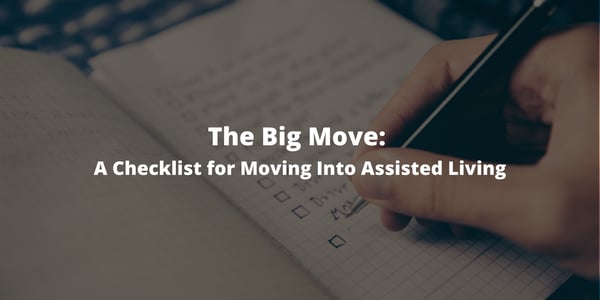Moving out of a family home after many decades seems akin to moving a mountain. If the move is to...
How to Choose? The Ultimate Assisted Living Facility Checklist
The quest for an appropriate assisted living residence for an aged loved one seems like a daunting task for families. The choices within a community range from large buildings with a hundred or more residents to smaller, home-like residences. Information about senior living choices abounds on the web. Families can easily scan among the options to make a list of residences to check out further.
After some research, initial telephone calls to the locations help to trim the list. These calls answer basic questions about the facility and allow the person in charge of admissions to learn more about the prospective resident. These calls narrow the list down to buildings worthy of onsite tours.
Tour Preparation
Unless there are medical or cognitive reasons, the prospective resident should participate in a tour of the facilities. His or her buy-in comprises the most crucial element in the transition to assisted living. Before the visit, review the facility's website and ask the person handling admissions coordination what to expect during the tour. Get directions to the building or load the address into a smartphone mapping app to avoid delays in arriving for the appointment.
Location
.jpg?width=300&name=pexels-pixabay-33488%20(2).jpg) When driving to the building, think about how close it is to loved ones. Is it an easy drive in all seasons? Look at the neighborhood. Is it pleasant with local amenities like stores and services nearby? Are there safe and attractive places to walk in the surrounding vicinity? Does there appear to be construction going in this area? If so, does it add loud noises and make transportation difficult? How long is it scheduled to last?
When driving to the building, think about how close it is to loved ones. Is it an easy drive in all seasons? Look at the neighborhood. Is it pleasant with local amenities like stores and services nearby? Are there safe and attractive places to walk in the surrounding vicinity? Does there appear to be construction going in this area? If so, does it add loud noises and make transportation difficult? How long is it scheduled to last?
The Building
Upon arrival, assess the parking situation. Is it on-street or off-street? Are there enough spaces for visitors? From the parking area, scan the building. Does it look attractive and well-maintained? Is there an overhang at the front door to provide weather protection for travelers entering and exiting vehicles?
Upon entering the building lobby, does it feel welcoming? Are there any unpleasant smells? (Keep track of this quality throughout the tour.) Do the common areas appear airy, well-lit, and uncluttered? Are there safe, pleasant areas outside the building for residents to sit or walk?
While walking through the building, is the layout easy to follow? Memory-impaired residents may have trouble navigating a confusing floorplan. What services are available onsite? Is there a café, hair salon, bank, general store, etc.?
What safety measures are apparent? Are there handrails in the hallways and grab bars in bathrooms? Are the floor coverings long nap carpet (tripping risk) or too smooth (slipping hazard)? Are there emergency pull-cords in the bathrooms and elsewhere? Are exits well-marked?
Policies
Understanding the policies of the facility is essential. Prospective residents and their families often neglect to ask enough questions and get surprised after the fact. For example, what is the policy on residents leaving and returning during the day if they are not cognitively impaired and in good health? What are the policies concerning visitors? Knowing all the policies that apply to residents will make for a smoother transition to assisted living.
Typically, assisted living quarters are considered to be apartments. They can be studio/efficiency or one or more bedrooms. If a resident signs a contract for a smaller apartment, how do they get on the waiting list for a larger unit? Are pets allowed? If so, what are the policies about the type and size of pets? What are the rules about pet care?
Most assisted living apartments have kitchenettes. What appliances, if any, are included? Are cupboards easy to reach? What foods and beverages are allowed to be kept in the apartment? How are laundry and housekeeping handled if the resident needs assistance with those? Is smoking allowed in apartments? If not, where is smoking allowed, if at all?
How is the bathroom set up? Aside from the necessary safety features, is there adequate storage? For that matter, how much closet and storage space in the rest of the unit? As for furniture, what are the policies on how much personal furniture can be in the apartment?
Residents
When touring the building, take note of the residents. Do they appear clean and well-groomed? If not, this may be a tip-off that care levels are sub-par. Do residents seem happy and comfortable? Are they socializing? Are you able to chat with residents about how they like the facility? How does the staff interact with them? Do there seem to be positive relationships with the staff?
Staff
 Speaking of the staff, how do they conduct themselves during the tour? The tour guide will make introductions along the way. Are staff members friendly and knowledgeable? Ask about staffing levels. Some senior care facilities have difficulty hiring enough people. Ask about how the facility trains its team to meet residents' needs.
Speaking of the staff, how do they conduct themselves during the tour? The tour guide will make introductions along the way. Are staff members friendly and knowledgeable? Ask about staffing levels. Some senior care facilities have difficulty hiring enough people. Ask about how the facility trains its team to meet residents' needs.
Another important staff responsibility is communication. How often does the staff communicate with the resident's family? It's a plus when communication happens regularly and not just when there is a problem.
Care Plans
Care plans (also known as service plans) are documents defining the details of care delivered to a resident. These plans start with an initial care conference attended by the facility staff, the family members, and the resident. The care plan covers all aspects of the resident's needs and how they will be met. Once the care plan is created, how often is it updated? How will the resident's family be notified if a change in the care plan is needed?
Learn more with our post, What is a Care Plan?
Contracts
Assisted living has many moving parts; this is reflected in the complexity of the contract with the facility. Residents and their families need to carefully review the agreement to fully understand the financial and policy implications of living in the facility.
For example, one crucial question to be answered is what happens if a resident is in the hospital and returns to the facility. Is the resident's apartment held for them when they are gone? If a resident needs to move out of the facility, how much notice must be given? In case of a legal dispute, is there mandatory mediation?
Financial
Most assisted living facilities are "private pay." This means the resident must tap their own financial resources. Assisted living contracts often require that residents have a certain threshold of assets to move into a facility. It is also important to understand what happens if a resident runs out of money. Does this mean the resident needs to move, or is Medicaid reimbursement accepted in this case?
What is included in the fees paid to the facility? Are all utilities included? What about the internet and cable TV? As a resident's needs change and more services are needed, how are these handled financially?
Another financial perspective is the fiscal health of the company delivering assisted living housing and services. Is the company financially sound? Are there any plans to sell the company? If yes, new owners may make unwelcome changes, so choosing that facility might be risky.
Medication and Healthcare
 Maintaining good health is a primary reason for moving to assisted living, so residents should expect high standards. What are the medical credentials of the staff? What procedures are in place for an emergency? How close is the nearest hospital? How often does a physician knowledgeable in geriatrics visit the facility? Are services like physical and occupational therapy handled by facility staff or a third-party contractor?
Maintaining good health is a primary reason for moving to assisted living, so residents should expect high standards. What are the medical credentials of the staff? What procedures are in place for an emergency? How close is the nearest hospital? How often does a physician knowledgeable in geriatrics visit the facility? Are services like physical and occupational therapy handled by facility staff or a third-party contractor?
Medication management is crucial for many assisted living residents. What are the procedures for consistent and safe medication administration? How are staff trained in these procedures? What are the double checks on these procedures to reduce the risk of medication errors? How are medications securely stored?
Dining
Nutritious and appealing meals rank at the top of many "must-have" lists. Sampling a meal can reveal a lot about food quality. Also, are the menus varied? Are special dietary requirements correctly handled as a matter of course? What do the residents say about food quality and quantity?
The dining experience becomes, for many residents, the social highlight of the day. Is the common dining area clean and appealing? Are dirty dishes cleared from tables quickly? Is in-room dining accommodated? In what ways does the facility make meals a special time for residents?
Activities
.jpg?width=300&name=bingo-game-flatlay%20(1).jpg) A lively and varied activities program speaks volumes about the culture of an assisted living situation. Efforts to provide a wide range of stimulating activities and events result in increased resident happiness and overall well-being. Look for schedules of activities. Are there activities both in the facility as well as field trips? Is there a dedicated library, game room, or handicraft studio? Make a point to meet the Activities Director. The creativity and energy of this person will be a good indicator of how fun and engaging the activities program is for residents.
A lively and varied activities program speaks volumes about the culture of an assisted living situation. Efforts to provide a wide range of stimulating activities and events result in increased resident happiness and overall well-being. Look for schedules of activities. Are there activities both in the facility as well as field trips? Is there a dedicated library, game room, or handicraft studio? Make a point to meet the Activities Director. The creativity and energy of this person will be a good indicator of how fun and engaging the activities program is for residents.
Transportation options can make the difference between a facility that feels vigorous and open versus one that feels like everyone is cooped up. Does the facility have its own transportation program? What is the cost to ride? How do residents make transportation arrangements? How reliable is the transportation? No one wants a resident to be stranded somewhere because the bus was late.
Summing It All Up
Assessing all the aspects of an assisted living facility is a big job. Ask a lot of questions. Gather data, but intuition is also essential. A facility needs to feel "right" for the resident and family since the decision will have long-lasting implications.
To help in the assessment process, Living50+ has prepared a PDF Assisted Living Checklist. Bring this on facility tours to ensure all bases are covered in the journey toward a new home.
Looking for more? Check out our Housing Resources and Long-term Care Resources pages to learn more about senior living options!





